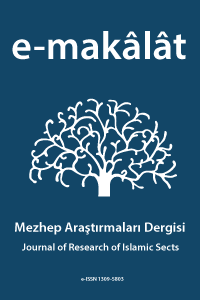İSLAMCI GENÇLER İLE İSLAMCI OLMAYAN GENÇLERİN MEZHEP ALGILARI ÜZERİNE KARŞILAŞTIRMALI BİR ARAŞTIRMA
Bu makale kendini İslamcı olarak tanımlayan gençlerle kendisini böyle tanımlamayan gençlerin mezhep olgusu karşısındaki algılarını ve tutumlarını karşılaştırmalı olarak incelemektedir. Araştırma, sosyal medya kullanan 17-35 yaş grubunu hedeflemektedir. Nicel araştırma tekniklerinden anket aracılığıyla gerçekleştirilmiştir. Pandemi döneminde sosyal medya kullanan gençler arasında başlatılan anket, kartopu tekniği ile yaygınlaştırılmıştır. Çeşitli internet ve sosyal medya araçları ile hedef kitleye ulaşılmaya çalışılmış, 1000 genç ile anket hedeflenmiştir. Ancak çabalara karşın ankete katılan kişi sayısı 778’le sınırlı kalmıştır. Katılımcıların bir kısmı, 35 yaş üzerinde olduğu için ankette değerlendirme sürecine alınmamıştır. Araştırma grubunda erkekler (yüzde 69) kadınlar (yüzde 31) oranında temsil edilmektedir. Gençlerin yaş ortalaması 24’tür. Eğitim itibariyle lise ve üniversite gençliği daha ağırlıklı bir konumdadır. Bu açıdan bakılınca gelir durumlarının düşük olması anlaşılır bir durumdur. Gençlerin büyük bir kısmı, hayatının önemli bir bölümünü il ve büyük şehirlerde (yüzde 72) geçirmiş olup halen yüzde 74’ü bu tip yerleşim yerlerinde yaşamaktadır. Araştırmadaki veriler analiz edildiğinde, İslamcı gençlerin diğerlerine kıyasla daha muhafazakâr ve geleneksel oldukları söylenebilir. İslamcı olmayan gençler çoğu konuda mezhepleri eleştirmekte, başka mezheplerden yararlanmanın faydalı olacağına inanmaktadırlar. Bu anlamda İslamcı olmayan gençler geleneksel görüşlerden ayrılmakta ve toplumun endişe edebileceği bir konuma doğru savrulmaktadır. Bulgular, gençler (özellikle de İslamcı olmayan gençler) arasında mezheplerin tabu olmadığını göstermektedir.
A Comparative Research on the Perceptions of The Islamist Youth and Non-Islamist Youth Towards Sect Phenomenon
This article comparatively examines the perceptions and attitudes of young people who define themselves as Islamists and those who do not define themselves as such, towards the phenomenon of sect. The research targets the 17-35 age group that uses social media. The research was conducted through survey, a data collection tool commonly used from quantitative research techniques. The survey, which was launched among young people using social media during the pandemic period, was popularized by the snowball technique. Facebook, Twitter, WhatsApp, Instagram, and Mail, such as internet and social media tools to reach the target audience, 1000 young people were targeted to conduct surveys. But despite all efforts, the number of respondents was limited to 778. Some of the participants were not included in the assessment process in the survey because they were over 35 years of age. Women (31 percent) are less represented in the research group compared to men (69 percent). The average age of the youth is 24 and singles constitute the majority. In terms of education, high school and university youth are more dominant. From this point of view, it is understandable that their income levels are low. Most of the young people have spent a significant part of their lives in provinces and big cities (72 percent), and still 74 percent of them live in such settlements. This means that in this study, mostly the religious identities and sectarian attitudes of urban youth are examined. When the views of young people participating in the study on sects are analyzed, it can be said that Islamist youth are more conservative and traditional compared to others. Non-Islamic youth criticize sects on many issues and believe that it will be particularly beneficial to benefit from other sects. In this sense, non-Islamist youth diverge from traditional views and are thrown into a position where society can worry. All these findings show that sects are not taboo among young people (especially non-Islamist youth), but are now a controversial issue. However, these findings do not mean that young people always have clear opinions about the phenomenon of sectarianism. Although they see sects as human formations and differentiation, they do not look favorably on the issue of updating them in our age. At this point, it can be said that there is a tendency to taboo sects.
___
- Büyükkara, Mehmet Ali. Çağdaş İslami Akımlar, İstanbul: Klasik Yayınları, 2015.
- Dilekli, Zeynep. Kendini Dindar Olarak Tanımlayan Gençlerin Aile Algısı Üzerine Sosyolojik Bir Araştırma:
Afyonkarahisar İli Örneği. Afyonkarahisar: Afyon Kocatepe Üniversitesi, Sosyal Bilimler Enstitüsü, Yüksek Lisans
Tezi, 2019.
- Ertit, Volkan. Endişeli Muhafazakârlar Çağı, Ankara: Orient Yayınları, 6.Baskı, 2020.
- Evkuran, Mehmet. “Çağdaş İslam Düşüncesinde “Mezhep” Krizi: Mezheplerin Dinsel/Teolojik Meşruiyeti ve
Sosyolojik Anlamı Üzerine”, Kelâm Araştırmaları Dergisi, 13/2. (2015), 615-633.
- Gerçek Hayat, “Anne Ben Deist Oldum”. Erişim 29 Ekim 2020. http://www.gercekhayat.com.tr/dosya/anne-ben-
deist-oldum/
- KONDA, “Biz Kimiz?”. Erişim 29 Eylül 2020. https://konda.com.tr/wp-
content/uploads/2017/02/2008_04_KONDA_Hayat_Tarzlari.pdf adresinden 29.09.2020 tarihinde alınmıştır.
- Koyuncu, Ahmet Ayhan. İslamcılık ve Demokrasi, İstanbul: Pınar Yayınları, 2018.
- Kuş, Elif. Nicel-Nitel Araştırma Teknikleri, Ankara: Anı Yayıncılık, 4.Baskı, 2012.
- Öz, Mustafa. Ana Hatlarıyla İslam Mezhepler Tarihi, İstanbul: Ensar Yayınları, 5. Basım, 2018.
- Üzüm, İlyas. "Mezhep". Türkiye Diyanet Vakfı Diyanet İslam Ansiklopedisi. 29/526-532, Ankara: TDV Yayınları,
2004.
